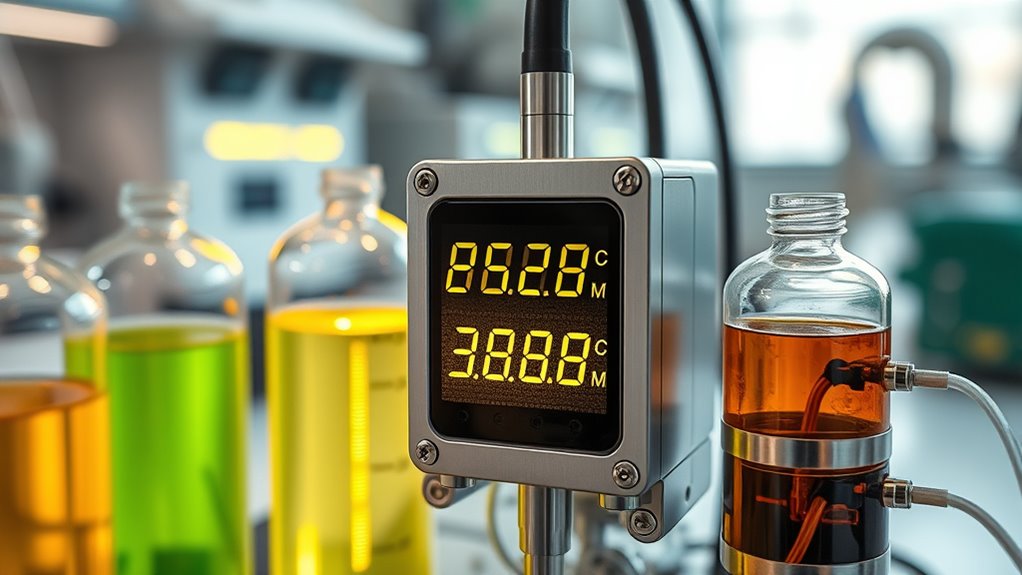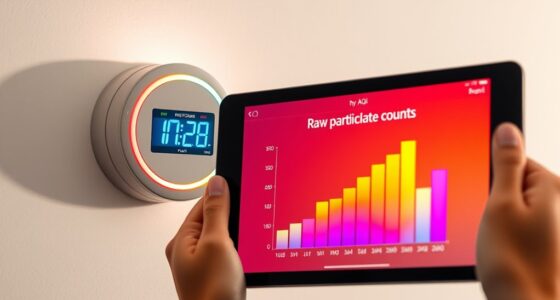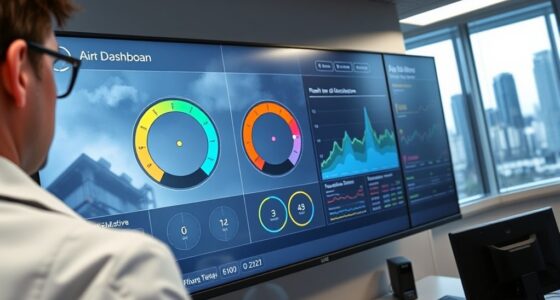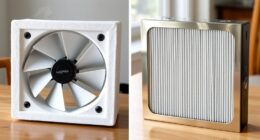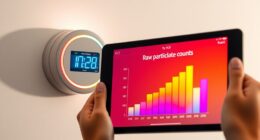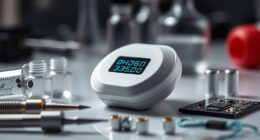To detect formaldehyde and VOCs, you can use electrochemical sensors or photoionization detectors (PIDs). Electrochemical sensors produce an electrical signal when they react with specific gases, making them cost-effective and suitable for continuous monitoring. PIDs ionize VOC molecules with UV light, allowing rapid detection of many compounds at low levels. Understanding these technologies helps you choose the right tool for your indoor air quality needs, and there’s more to discover about their unique capabilities.
Key Takeaways
- Electrochemical sensors detect formaldehyde and VOCs through chemical reactions, providing real-time, specific measurements.
- Photoionization detectors use UV light to ionize VOC molecules, enabling rapid detection of a wide range of organic compounds.
- Electrochemical sensors are cost-effective, portable, and suitable for continuous monitoring of formaldehyde levels.
- PIDs offer high sensitivity and can identify low concentrations of diverse VOCs quickly and efficiently.
- Combining sensor technologies enhances indoor air quality monitoring for health safety and regulatory compliance.
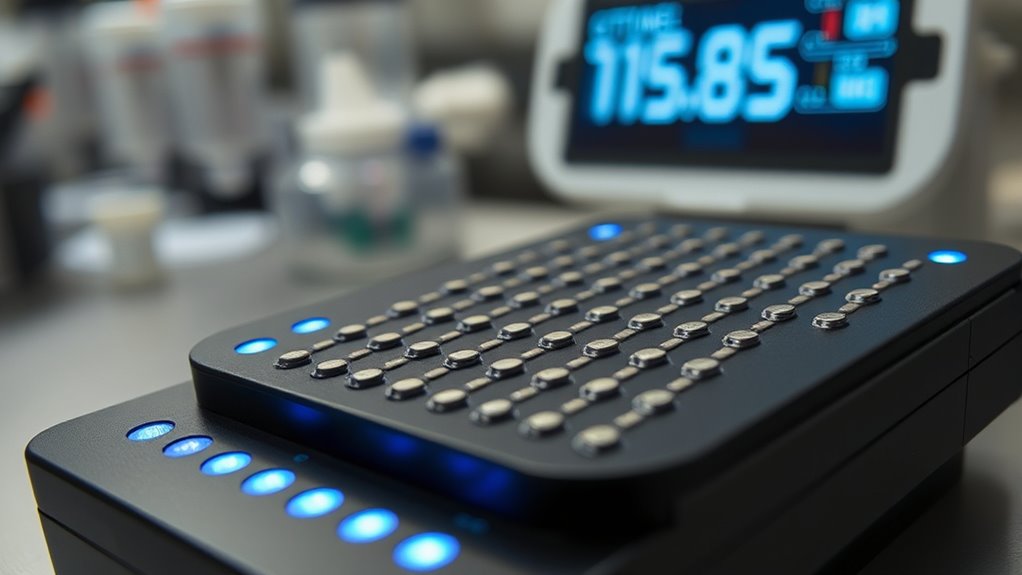
Detecting formaldehyde and volatile organic compounds (VOCs) is essential for maintaining indoor air quality and ensuring safety. When you want to monitor these harmful substances, sensor technologies like electrochemical sensors and photoionization detectors (PIDs) are your best options. These devices help you identify and measure airborne pollutants accurately, enabling you to take prompt action before health issues arise.
Electrochemical sensors work by producing an electrical signal proportional to the concentration of specific gases. When you use an electrochemical sensor for formaldehyde or VOC detection, you place it within the environment you’re monitoring. As the target gas interacts with the sensor’s chemical compounds, a reaction occurs that generates a measurable electrical current. This current correlates directly with the gas concentration, providing real-time data. These sensors are known for their high sensitivity, quick response times, and ability to operate continuously. They are ideal for applications where you need constant monitoring, such as in homes, offices, or industrial settings. Their compact size and low power consumption make them suitable for portable detectors or integration into larger air quality systems.
Photoionization detectors, on the other hand, use ultraviolet (UV) light to ionize VOC molecules present in the air. When you activate a PID, it exposes the air sample to UV radiation, which causes the VOC molecules to lose electrons and become ionized. The resulting ions produce an electrical current that is measured to determine the VOC concentration. PIDs are highly sensitive and capable of detecting a wide range of organic compounds at very low levels, often down to parts per billion (ppb). Because they can quickly analyze complex mixtures of VOCs, PIDs are particularly valuable in environments where rapid detection of multiple compounds is necessary, such as laboratories, manufacturing facilities, or environmental assessments.
Both electrochemical sensors and photoionization detectors offer distinct advantages. Electrochemical sensors are generally more selective and cost-effective for specific gases like formaldehyde, while PIDs excel at detecting a broad spectrum of VOCs with exceptional sensitivity. When choosing a sensor technology, consider factors such as the types of gases you need to detect, response time, accuracy, and your budget. By understanding how these sensors operate and their strengths, you can better safeguard indoor air quality, protect health, and comply with safety standards. For example, mindfulness practices can help reduce exposure to indoor pollutants by promoting stress reduction and healthier living environments. Whether for personal use or industrial applications, integrating these sensors into your air monitoring system ensures that you stay informed about the presence of harmful formaldehyde and VOCs, allowing you to act swiftly and confidently.
Frequently Asked Questions
How Long Do Formaldehyde Sensors Typically Last Before Calibration?
You can expect formaldehyde sensors to last about 6 to 12 months before requiring calibration, depending on usage and environment. Sensor lifespan varies, so monitoring for drifting readings is essential. Regular calibration, typically every 3 to 6 months, ensures accuracy. Keep an eye on manufacturer guidelines and environmental conditions, as these factors influence how often you should calibrate your sensor to maintain reliable detection of formaldehyde levels.
Are There Portable Devices for Real-Time VOC Detection?
Did you know that over 60% of people want real-time air quality data? Yes, portable devices for VOC detection are available, offering quick, on-the-spot readings. These gadgets often connect to mobile applications, allowing you to monitor air quality anywhere. With data connectivity, you can track trends over time, receive alerts, and make sure your environment stays safe. They’re perfect for both home use and on-the-go health awareness.
What Are the Environmental Factors Affecting Sensor Accuracy?
Environmental factors like humidity interference and temperature fluctuations can impact your sensor’s accuracy. High humidity levels may cause false readings or sensor drift, reducing reliability. Temperature changes can also skew results, making it harder to detect true VOC or formaldehyde levels. To guarantee precise measurements, keep your sensor in a stable environment, avoid extreme conditions, and regularly calibrate it to account for these environmental influences.
Can Sensors Differentiate Between Different Types of VOCS?
Yes, sensors can differentiate between different types of VOCs through sensor specificity and VOC differentiation. You’ll find that advanced sensors use unique chemical signatures, selective sensing materials, and pattern recognition algorithms to distinguish various VOCs. This allows you to identify specific compounds accurately, monitor air quality precisely, and respond appropriately. By leveraging these technologies, you gain detailed insights into your environment, ensuring better safety and healthier living or working spaces.
How Do Sensor Costs Vary With Detection Sensitivity?
Sensor costs generally increase with higher detection sensitivity because more advanced technology is needed for precise measurements. You’ll find that cost performance improves as you balance sensitivity with affordability, especially for large-scale applications. Scalability also plays a role; sensors designed for broader deployment may be more cost-effective overall, but initial investments might be higher for those with superior sensitivity. Ultimately, choosing the right sensor depends on your specific detection needs and budget constraints.
Conclusion
By now, you see how these sensor technologies act like vigilant guardians, tirelessly sniffing out formaldehyde and VOCs lurking in your environment. They’re your first line of defense, turning invisible threats into clear, actionable data. Think of them as your personal air quality detectives, always on alert. With these tools, you can breathe easier, knowing you’re equipped to keep your space safe and pure—transforming the air you breathe from a hidden danger into a well-guarded sanctuary.
